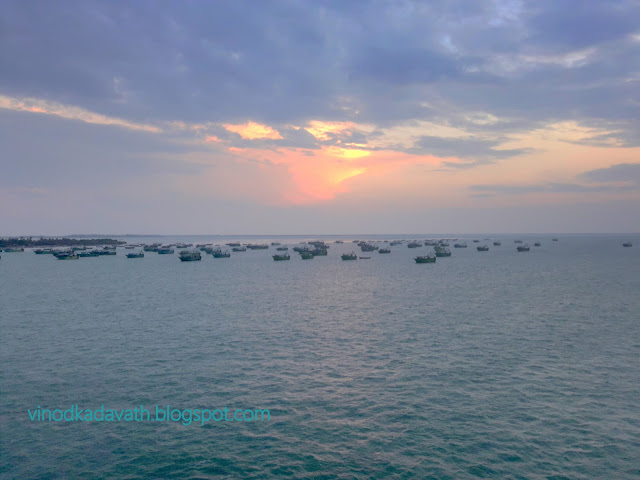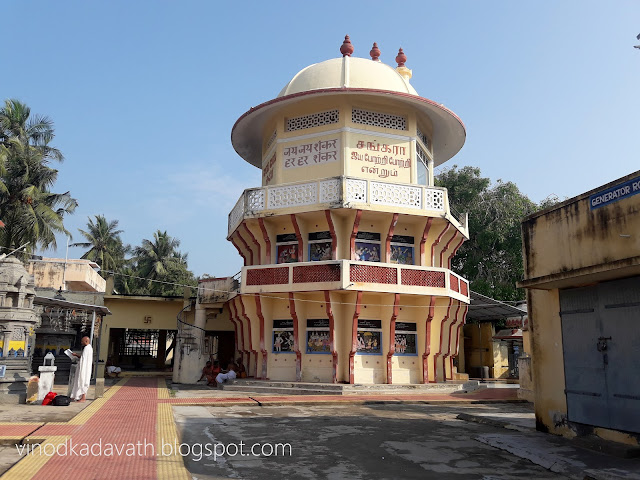
After years of planning , I finally got an opportunity for a trip to Rameswaram. Since it was not possible to see everything that we wanted to see, we decided to focus our trip on three places - Madurai, Rameswaram and Dhanushkodi. We finally left for Rameswaram from Kochi on the evening of November 23rd.
Our route was via NH 45 Adimali/Theni/Kambam/Madurai
24.11.2018 - Day 1
It was around 9 am, when we reached Madurai. After refreshment and breakfast, we reached the South Gopura of Madurai Meenakshi temple. The temple was surrounded by shops and hotels. The temple has four towers or 'gopurams, with entry gate each and are engraved with beautiful sculptures of demons and gods. You are restricted from carrying cameras, mobile phones, bottles and food. The temple provides free cloak/footwear room near to the South Gopura.
The temple complex has many mandapas (pillared-halls). Near to the South Gopura is a sacred temple tank , called Porthamarai Kulam ("Pond with the golden lotus"). Surrounding the temple tank, there were 64 pictures of Shiva's Thiruvilayadals (miracles). On the western side of the tank, you can see a small portico where you can see a portion of 17th and 18th century paintings of Nayak period. It depicts the marriage of Sundareswarar and Meenkashi attended by Vijayaranga Chokkanatha and Rani Mangammal. After prayers, we visited Thousand Pillar Hall and it contains 985 (instead of 1000) carved pillars.
Prayers over, we returned to the hotel and checked out. Next up was Paazhamudur Cholai Temple. Before boarding the bus, we bought some sweets from age old shops who sells Halwa made up of pure ghee and sugar.
Reached Paazhamudur Cholai Temple at around 11 am which is considered as one of the six important abodes of Lord Muruga. . It is situated atop a hill covered with dense forests, and there were many monkeys around the temple.
Coming out, I could see a long queue to collect food which was donated by an organisation.
Next up was Rameshwaram. By this time, it was lunchtime and we were searching for good restaurants along the way, which seemed hard especially in rural Tamilnadu. Finally, we stopped at one hotel near Sivakasi. With lunch over, we pushed on towards Rameswaram. The road was good with less traffic. Once everyone settled in the bus, our coordinator put one Malayalam film.
It was 6 PM when we reached the Pamban Bridge. The Pamban bridge - Road bridge and the Railway bridge - connects the shores of Mandapam and Pampan - the starting point of Rameshwaram island.
The bus dropped us in the middle of the bridge and allowed us to walk till end of the bridge. We could see the area built across the rail bridge where boats passes through and the bridge would lift up when the boat comes. We could see Fish Landing Centre from the bridge. By that time sun started to set creating a mixture of orange, yellow and dark blue hues.
Our accomodation was arranged in Hotel RSN International located in Sannadhi St and is a walk-able distance to the Temple and the Agni Theertham. I was tired after a long journey. After dinner, me and one of my co traveller walked around the temple to photograph the stunning views of Gopura and the life around the temple. There were small tea shops and hotels around the temple selling tea and food. Cows were roaming around the street which reminisce me of the Varanasi streets.
11.00 pm. time to bed. Went back to hotel. It was worth to spend the night in a hotel located near to the temple and the beach. Last goodbye to day's hectic travel, quick shower and off to bed after a fantastic day.
25.11.2028 - Day 2
In the early morning at 5.30 our guide reached our hotel to help us to take bath in Theertham and other rituals. Wearing white Dhoti we walked towards Agni Teertham. First we visited the Sri Kanchi Kamakoti Peetam. Statues of Sri Adi Sankara with his four principal disciples is located at the top of the tower, facing the sea. The Life History of Adi Sankara is depicted in the form of carvings on the tower.
AGNI THEERTHAM
Agni theertham sea is located just 50 meter from the Rameswaram temple. Those who wanted to take sacred bath should first take bath in Agni theertham and followed by bath in theerthams inside the temple. The ghats were caught up in the early morning bustle. Facilities are available for those who wanted to take holistic rituals such as tharpanam(ritual for the ancestors who were dead). After bath, all of us went ahead to Rameswaram temple in wet cloths for holy bath in 22 wells.
After bath in 22 wells inside the temple, we came back to hotel to change our dress. Then proceeded to temple visit.
Photography is strictly prohibited inside the temple premises. You can take special pass for Rs.50. A huge Nandi idol is placed in the entrance. We were about to hear an interesting story from our guide.The Shiva lingam of Lord Rameswaram is one of the twelve Jyotirlingas. It is believed that Sri Rama worshiped the Shiva Lingam of Lord Siva. After Ravana's death, Lord Rama came to Rameshwaram with Lord Sita and decided to worship the deity of Shivalingam and perform pooja to save his sins. But Hanuman was unable to bring Shivlingam on time. But Sita created one Shivlingam by spraying salt water into the sand of the sea and the same was installed at that moment. After that, Hanuman arrived from Kailash with Shiva Lingam. It is believed that seeing the face of the sad and angry Hanuman, the new shivlingam was placed near to the shivalingam of Sita. Since Lord Rama, the incarnation of Lord Vishnu, worshiped the Shiva Linga (Shiva) by his own hand, the Vaishna Saiva Vedanta devotees comes to pray here. It is believed that if you pray in this temple, all sins will be washed away.
We walked through the third corridor, which is said to be the longest pillared corridor in the world with its 1212 pillars. The carvings on the pillars have been painted in bright colors.
Arrived back to hotel, checked out, left our luggage inside the bus. After a leisurely breakfast, moved out to visit Dhanushkodi.
DHANUSHKODI
Since heavy vehicles are not permitted to Dhanushkodi, we hired a small van. Dhanushkodi is around 20 kms from Rameswaram. When the van crossed the city limit, I tried to remember the tragedy that happened to Dhanushkodi 56 years back. It was on 22 December 1962, when the clock turned 23.55, one passenger train with around 150 people was crossing Pamban to Dhanushkodi, when suddenly a strong wind followed by heavy rain washed out Dhanushkodi and the train drowned in the high tides and all of the passengers died. Two villages and port city vanished and 1800 humans died from Pampan island. Entire Dhanushkodi was wiped out. Dhanuskodi is declared as a ghost town by the government after this natural calamity.
The road was empty and we could see only travelers along the way. Both side of the road were tied with big stones to protect from waves.The left side of the road is Indian Ocean and right side is Bay of Bengal.When Dhanushkodi approached, we could see people living in bamboo houses. Fishing is the main occupation. There are many shops on both sides of the road.

Dhanushkodi was a major port city in Bengal cost since British rule. It has port, railway station, water tank, post office, church, temple , hospital, school , hotels and other shops. Now we could see only ruins. It was also famous for people coming here for Bali karma.
On the left, we saw the remains of the old railway station.
Near to the Old railway station is an old Tank.
You can see parts of the old mosque on the right side of the road. They are many stalls near to the mosque which sells Shakh and chippi.
Wading through stories, we finally reached the tip of Dhanushkodi. The bus dropped us at the end of the road and it is the last turnaround of South India. In the middle you can see an Ashoka Stupa. This is the place where seas Indian ocean (A sea with high tides) and Bay of Bengal (the low tide sea) merges. The area was crowded with people and vehicles. This is the land border of India and Srilanka which is nearly about 15 kms from here. It is believed that Ram Sethu was built from here to Sri Lanka.
People from the locality were selling cut fruits, nuts etc. and they do not have any other income sources in this place. Before heading back to Rameswaram, try to taste those fruit cuts - mango, pineapple , etc. from local people.
Dr. APJ Abdul Kalam Monument
This is the last place in our chart before leaving Rameswaram. It showcases memories from the life of Dr.APJ Abdul Kalam. Curious to know more, I entered the museum with high expectations. Dr. Kalam's life is depicted through portraits. Statues of Dr. Kalam in presidential suite, in sitting and standing, last moments in his life is also displayed here. In another section, personal belongings of Dr.Kalam, sample model of missiles and rockets with which Dr.Kalam had worked are also displayed. Photography inside the memorial is prohibited for visitors. If you complete the inside views, the outdoors are perfectly sublime.
 |
| Dr. APJ Abdul Kalam Monument |
After lunch we started our return journey. When we crossed the Pampan bridge, we could see lots of peacock's in the railway track.


























super vinod bhai, really informative.
ReplyDeleteits nice detailed travelogue and very informative. Your information is good…..
ReplyDeleteits very use article.
Madurai to Rameswaram Cabs
Thanks for your effort and it will be very useful for coming tourist Thanks
ReplyDeleteImpressive!Thanks for the post
ReplyDeleteBest Travel Agency in Madurai | Travels in Madurai
Madurai Travels | Best Travels in Madurai
Tours and Travels in Madurai | Best Tour Operators in Madurai
Nice one. Enjoyed reading this, especially since I did a trip recently to Madurai/Rameshwaram and hence could related to a lot of what you have written.
ReplyDelete